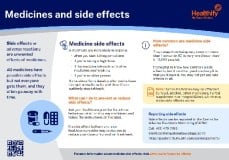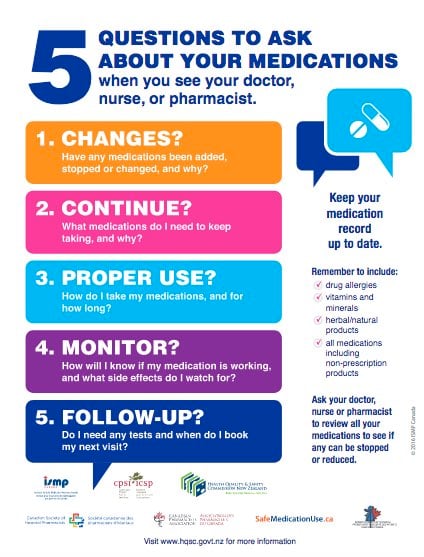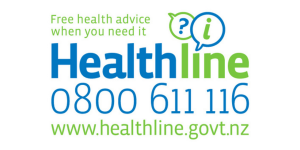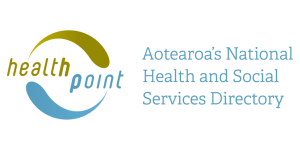Tranexamic acid
Sounds like 'tran-ex-am-ik ass-id'
Key points about tranexamic acid
- Tranexamic acid is used to reduce or stop heavy bleeding.
- Tranexamic acid is also called Cyklokapron®.
- Find out how to take it safely and possible side effects.

Tranexamic acid is used to reduce or stop heavy bleeding caused by heavy menstrual periods, nose bleeds, dental procedures or surgery (operations).
Tranexamic acid works by slowing the breakdown of clots. When you bleed, your body forms blood clots to stop the bleeding. In some people these clots break down (or dissolve), causing too much bleeding.
By slowing the breakdown of clots, tranexamic acid prevents further bleeding.
In Aotearoa New Zealand, tranexamic acid is available as tablets (500 mg) and can also be given as an injection in the hospital. It’s available with a prescription written by a prescriber.
- Always take your tranexamic acid exactly as your healthcare provider has told you. The pharmacy label on your medicine will tell you how much tranexamic acid to take, how often to take it, and any special instructions.
- The dose of tranexamic will be different depending on its use. You usually only need to take tranexamic acid for a short time.
- The usual dose of tranexamic acid for adults is 2 or 3 tablets taken two or three times a day.
- Some people may need higher doses.
- Your healthcare provider will advise you how many days to take tranexamic acid for.
- Timing: Take your tranexamic acid tablets at the same times each day.
- Water: Swallow your tablets with a glass of water.
- Food: You can take tranexamic acid with or without food.
- Missed dose: If you forget to take your dose, take it as soon as you remember, but if it's nearly time for your next dose, just take the next dose at the usual time. Don't take double the dose.
- Other medicines: Tranexamic acid interacts with some medicines, herbal supplements and rongoā Māori, so check with your healthcare provider before starting tranexamic acid and before starting any new products.
- Pregnancy or breastfeeding: Talk to your healthcare provider if you're pregnant, planning a pregnancy or want to breastfeed.
Like all medicines tranexamic acid can cause side effects, although not everyone gets them. If you're concerned about any symptoms you think might be related to your medicine, talk to your healthcare provider. The following information offers some guidance but doesn't include all possible side effects.
Common side effects
Tell your healthcare provider if these side effects bother you.
- Nausea (feeling sick), vomiting (being sick).
- A sore stomach or diarrhoea (runny poo).
Tell your healthcare provider immediately or phone Healthline free on 0800 611 116 if these occur
- Problems with your eyesight such as changes in your colour vision.
- Signs of clots in the legs or the lung such as swelling, redness or cramping in the legs, or shortness of breath, difficulty breathing, or chest pain.
Phone 111 for an ambulance or go to your nearest accident and emergency (A&E) clinic if these occur
- Signs of an allergic reaction such as itchy skin, and rash, swollen lips or tongue, problems breathing, like a tight chest or shortness of breath.
Read more about medicines and side effects and reporting a reaction you think might be a side effect.
The following links have more information on tranexamic acid:
Tranexamic acid tablets(external link) Medsafe Consumer Medicine Information, NZ
Tranexamic acid (tablet)(external link) New Zealand Formulary Patient Information
Brochures
Medicines and side effects(external link) Healthify He Puna Waiora, NZ, 2024
5 questions to ask about your medications(external link) Health Quality and Safety Commission, NZ, 2019 English(external link), te reo Māori(external link)
References
- Tranexamic acid(external link) New Zealand Formulary
- Cyklokapron(external link) Medsafe datasheet, NZ
- Investigating and managing abnormal vaginal bleeding: an overview(external link) BPAC, NZ, 2019
- Tranexamic acid for the treatment or prevention of bleeding(external link) Medicines for Children, UK
Brochures

Medicines and side effects
Healthify He Puna Waiora, NZ, 2024

Health Quality and Safety Commission, NZ, 2019 English, te reo Māori
Credits: Healthify editorial team. Healthify is brought to you by Health Navigator Charitable Trust.
Reviewed by: Stephanie Yee, Pharmacist, Auckland.
Last reviewed:





